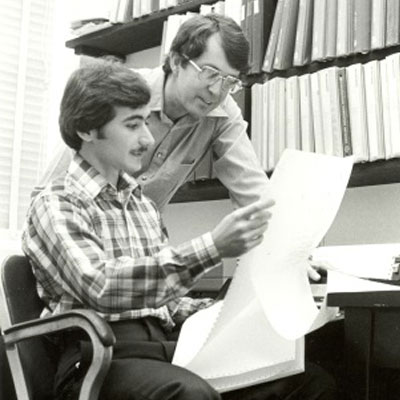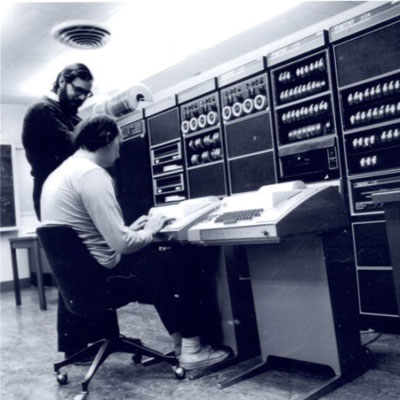A certain computer company named after a fruit was founded 40 years ago. You may have heard of it. It was the same year the Viking 1 successfully landed on Mars, and NASA released the famous Face on Mars photo.
This year also marks the 40th anniversary of another key discovery that few remember, but everyone uses. This discovery had a profound impact on how we analyze, visualize and manipulate data.
At AT&T Labs, our software heritage dates back to 1976, when John Chambers, Rick Becker, and Allan Wilks developed S, the first open source statistical language at Bell Labs.
The creation of S programming language changed the computing environment forever. Before S most data analysis wasn’t visual or interactive like it is today. S became even easier to use when interfaces started using S data structures and other software languages.

Caption: Research fellowship program Edward Zayas (seated) and mentor John Chambers (standing) look over a program in progress for the study of statistical data.
At the same time, researchers were creating the basic foundation of the Internet, Unix, and realized they could build S on top of Unix. This would make it widely available to data scientists and programmers.

Caption: Ken Thompson and Dennis Ritchie, creators of the UNIX operating system (1969-1971).
We haven’t made a big deal about the anniversary because, frankly, we’re used to them by now. More than 140 years ago, founder Alexander Graham Bell invented the telephone. AT&T has a legacy since then of eight Nobel Prizes and more than 12,500 AT&T-issued patents worldwide. And we’re continuing to evolve. Now, we’re leading the tech industry through a fundamental transformation.

Caption: To and from San Francisco in October, 1989, following the devastating earthquake that struck the Bay Area.
Today, hundreds of innovative scientists, technologists and engineers bring their knowledge to our labs to build the network of the future. They’re behind the scenes focusing on research and development in Big Data, software-defined networks, network function virtualization, and Intelligent Systems. They make your network smarter, faster and more nimble with Networking and Service Quality Management.
See these terms come to life:
- Connected Corridor: We’ve worked with the University of California, Berkeley and the California Department of Transportation (Caltrans) to explore how research can help develop smarter traffic design through data visualization.
- RCloud: We developed a collaborative cloud platform built that enables developers to access and deploy code their peers have already created across coding languages.
- Nanocubes: We created data visualization technology that allows users to interact with massively large datasets via a standard laptop or tablet.
We’re proud of our past. But our focus is on the future. We’re shifting network control from hardware to software. This will allow for seamless live streaming and connected homes, with things like automatic lighting adjusting day to night. We’re building a network that can keep up with you.
